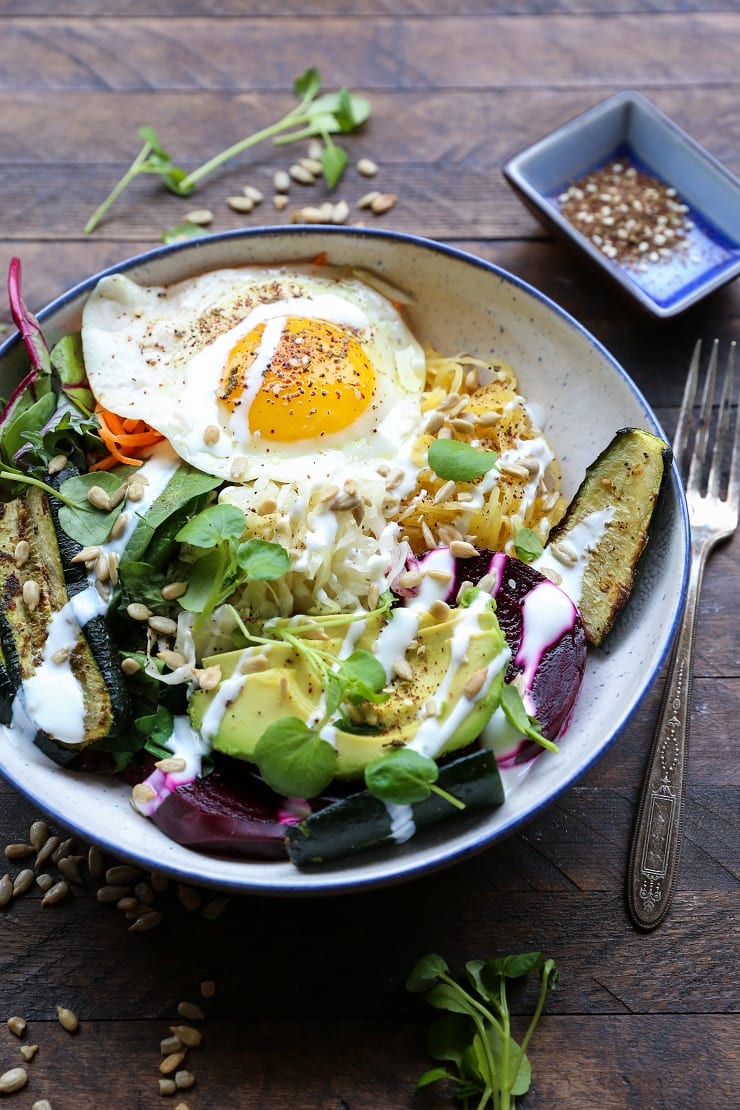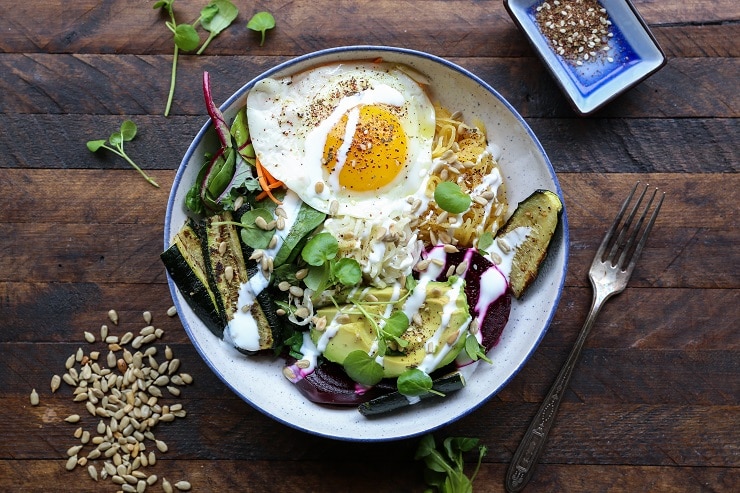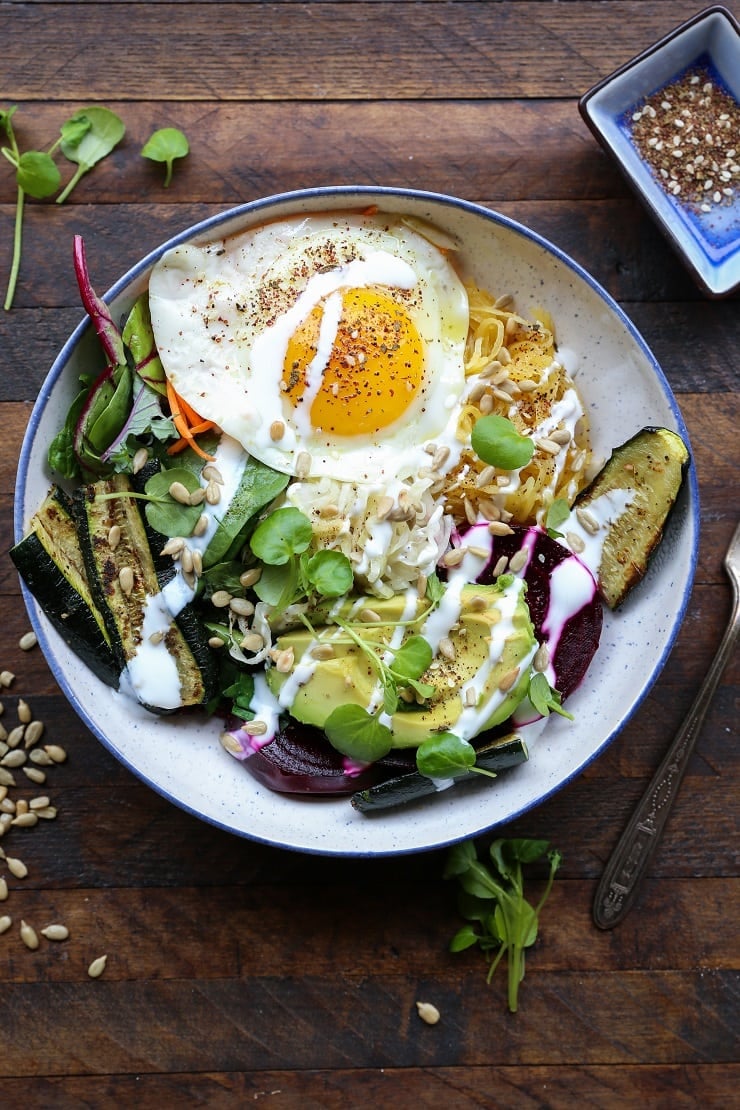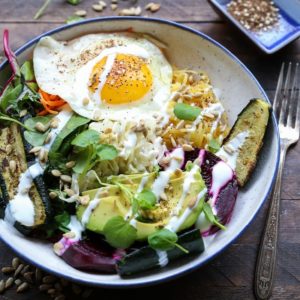How to make a nutrient-dense prebiotic and probiotic macro bowl to restore digestive balance and and build a healthy gut.

While the topic of gut health is overwhelmingly extensive, and {{disclaimer}} I’m not a medical professional, I thought I’d give you a little taste of the type of foods I eat regularly to maintain digestive balance. The purpose of this post is to offer a meal concept, and a recipe to ideally make your digestive system swoon.
If I were to sum up everything I’ve learned about digestive health into one single piece of advice, it would be to feed your good bacteria, not your bad bacteria.
What feeds bad bacteria? Foods high in sugar (this includes natural sweeteners!), starches, processed foods, too many grains (in particular, processed, and/or bleached grains or carbohydrates). What feeds good bacteria? Natural whole foods, particularly raw vegetables – in essence, dietary fiber. We should be aiming for a largely plant-based diet, along with lean protein and healthy fat for optimal energy and nutrient absorption.
So let’s dive into food that will support, grow, and nourish the peaceful bacteria in your gut while creating an environment that is unfavorable for bad bacteria to grow. What we need are both prebiotics and probiotics, both of which can be found abundantly in nature. What are they and how do we get them? Lettuce discuss.
Prebiotics
Prebiotics are food-based compounds that provide nourishment to probiotics. They come in the form of complex carbohydrates or polysaccharides, which are a pure form of dietary fiber. When prebiotics enter the colon, they are broken down (essentially fermented) by bacteria, which enables them to reproduce. Essentially, probiotics need prebiotics in order to remain well-fed and happy.
Prebiotic foods include (you guessed it): raw vegetables and some fruit. Foods that are particularly high in their prebiotic plant fiber are Jerusalem artichokes (a.k.a. sunchokes), chicory root, dandelion greens, garlic, onions, leeks, jicama, asparagus, wheat, and bananas.
Note if you have a FODMAP sensistivity, many of the above mentioned prebiotic foods don’t bode well with your digestive system. Choose other nutrient-dense raw and cooked vegetables, such as kale, collard greens, carrot, parsnips, butternut squash, broccoli, etc. as your source of prebiotics.
There are also prebiotic supplements available (which contain inulin), but I would highly recommend doing research on the best sources before jumping into a specific brand. I’d always recommend getting your prebiotics with raw produce rather than buying supplements if possible.
Probiotics
The wonderful little creatures (helpful bacteria and yeast) that inhabit your gut that help break down food for optimal absorption, and fight pathogens and bad bacteria, thereby keeping your immune system high and your body well.
In my opinion, the best way to source your probiotics is through naturally fermented food, such as pickled vegetables, kimchi, sauerkraut, yogurt, and kefir, fermented drinks (not including alcohol) like kombucha, homebrewed ginger beer, rejuvalac, beet kvass, etc. Hint: If you’re interested in fermenting your own beverages or making your own yogurt at home, check out my cookbook, Delicious Probiotic Drinks.
Note: if you’re intolerant to (or prefer to avoid) dairy, you can also make your own dairy-free yogurt and kefir at home, or there are now many options for store-bought non-dairy yogurt and kefir.
The reason I recommend sourcing probiotics from fermented foods verses supplements is the probiotic supplement industry is convoluted, overwhelming, and unregulated and many of the supplments don’t contain the concentration stated on the label, plus your body may need an entirely differet probiotic strain than the one(s) contained in the product. Fermented foods contain a large variety of probiotic strains, so the likelihood you’ll end up consuming a strain your body needs is much higher than if you take a shot in the dark with probiotic supplements.
Putting prebiotic and probiotic whole foods together creates for a highly nutritious – do I daresay, superfood – meal.

Macro Bowl
So…what is a macro bowl? A macro bowl is a meal containing all the macro nutrients you need: carbs, fat, and protein. The optimal macro bowl includes nutrient-dense foods so you get the most bang for your buck.
You’ll notice this particular recipe doesn’t include a ginormous amount of carbs. You can absolutely use brown rice or toasted whole grain bread as your carbohydrate source if you have no dietary issues with them!
There are so many options for customization here, it’s ridiculous, but to exemplify a happy tummy meal, I have included a variety of raw greens (spinach, chard, kale, beet greens), raw grated carrot, roasted beets (you can do pickled beets!), roasted zucchini, sauerkraut, spaghetti squash (<- not an amazing prebiotic, but a great source for “faux” carbs to make the meal feel satisfying), avocado, sunny side up egg, and a drizzle of kefir (I used goat milk kefir. If you’re intolerant to dairy, a dollop of your favorite non-dairy yogurt is a great replacement option).
Sound scrumptious? You can say no.
Even I, lover of vegetables, would prefer a big steamy bowl of rice, beans, cheese, and grilled chicken over a bowl like this any day. If I’m being honest, while I do find macro bowls like this to be pleasant, I don’t find them to be sinfully succulent; however, I do find them to be extremely well-received by my digestive system. The key here is to create a bowl using your favorite nutritious foods to get the best dining experience for your own palate.
Build Your Own Macro Bowl:
Choose your adventure! (Hint: the ingredients that are italicized are very high in prebiotics)
- Leafy Greens: dandelion greens, baby spinach, chard, beet greens, kale, micro greens, butter lettuce
- Raw Vegetables: onion, jicama, carrot, peppers, cucumber, tomato,
- Roasted, Steamed, or Sauteed Vegetables: sunchokes, asparagus, garlic, beets, sweet potato, turnip, broccoli, cauliflower, zucchini, carrot, onion, leeks,
- Complex Carbohydrates, or “Faux” Carbs: sprouted brown rice (or rice of choice), quinoa, farro, spaghetti squash, cauliflower rice, beet rice, cabbage rice (see these Cabbage Rice Fajita Bowls from Making Thyme for Health for example).
- Protein: eggs, beans (black, gabanzo, kidney), grilled salmon or chicken
- Probiotic Fermented Foods: pickled beets, homemade sauerkraut (if using store-bought sauerkraut, make sure the package states it contains live probiotics), kimchi, pickled red onion
- Probiotic Sauces: kefir, Tzatziki Sauce, Fig Kombucha Vinaigrette
- Other Sauce/Spread Options for Flavor: Beet Green Pesto, Kale Pesto, Roasted Beet and Garlic Hummus
Side Note: if you have a digestive ailment, food sensitivities or intolerances, a FODMAP sensitivity, or autoimmune disease, choose foods you know your body will digest in peace.

Personal note: I try to eat meals like this regularly in order to keep my system in check, but law knows I’m not perfect and sometimes my stints of less-than-optimal eating cause my sensitive GI tract to get out of whack. When my digestive system is in shambles, I put everything on pause and eat meals like this. If you’re like me and have a sensitive tummy, try regularly consuming prebiotic and probiotic foods to help your insides stay happy.
So there you have it! May your gut biotics forever remain in a peaceful state.

Prebiotic and Probiotic Macro Bowls
A general recipe for building your own prebiotic and probiotic macro bowl
Original article and pictures take www.theroastedroot.net site
Комментариев нет:
Отправить комментарий